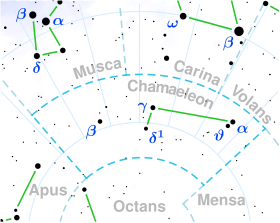Astronomy:HD 94717
| Observation data Epoch J2000.0 Equinox (celestial coordinates) | |
|---|---|
| Constellation | Chamaeleon |
| Right ascension | 10h 52m 28.63166s[1] |
| Declination | −79° 33′ 33.9765″[1] |
| Apparent magnitude (V) | 6.34±0.01[2] |
| Characteristics | |
| Spectral type | K2 II/III[3] |
| U−B color index | +1.57[4] |
| B−V color index | +1.46[4] |
| Astrometry | |
| Radial velocity (Rv) | 3.4±0.5[5] km/s |
| Proper motion (μ) | RA: −11.341[1] mas/yr Dec.: +1.655[1] mas/yr |
| Parallax (π) | 1.8682 ± 0.021[1] mas |
| Distance | 1,750 ± 20 ly (535 ± 6 pc) |
| Absolute magnitude (MV) | −2.10[6] |
| Details | |
| Mass | 6.3±0.7[7] M☉ |
| Radius | 77.8±3.9[8] R☉ |
| Luminosity | 1,847+46−49[1] L☉ |
| Surface gravity (log g) | 1.47±0.04[1] cgs |
| Temperature | 4,446±122[9] K |
| Metallicity [Fe/H] | −0.01[1] dex |
| Rotational velocity (v sin i) | 2.4±1.3[10] km/s |
| Age | 63±20[7] Myr |
| Other designations | |
| Database references | |
| SIMBAD | data |
HD 94717, also known as HR 4268, is a solitary orange hued star located in the southern circumpolar constellation Chamaeleon. It has an apparent magnitude of 6.34,[2] placing it near the limit for naked eye visibility. The object is located relatively far at a distance of 1,750 light years based on Gaia DR3 parallax measurements,[1] but it is receding with a heliocentric radial velocity of 3.4 km/s.[5] At its current distance, HD 94717's brightness is diminished by 0.62 magnitudes due to interstellar dust.[12]
HD 94717 has a stellar classification of K2 II/III,[3] indicating that it is an evolved red giant with the blended luminosity class of a giant star and a bright giant. It is estimated to be 63 million years old,[7] enough time for it to cool and expand to 78 times the Sun's radius.[8] It has 6.3 times the mass of the Sun[7] and radiates 1,847 times the luminosity of the Sun[1] from its photosphere at an effective temperature of 4,446 K.[9] HD 94717 has a solar metallicity[1] and spins modestly with a projected rotational velocity of 2.4 km/s.[10]
References
- ↑ 1.0 1.1 1.2 1.3 1.4 1.5 1.6 1.7 1.8 1.9 Vallenari, A. et al. (2022). "Gaia Data Release 3. Summary of the content and survey properties". Astronomy & Astrophysics. doi:10.1051/0004-6361/202243940 Gaia DR3 record for this source at VizieR.
- ↑ 2.0 2.1 Høg, E.; Fabricius, C.; Makarov, V. V.; Urban, S.; Corbin, T.; Wycoff, G.; Bastian, U.; Schwekendiek, P. et al. (March 2000). "The Tycho-2 catalogue of the 2.5 million brightest stars". Astronomy and Astrophysics 355: L27–L30. ISSN 0004-6361. Bibcode: 2000A&A...355L..27H.
- ↑ 3.0 3.1 Houk, N.; Cowley, A. P. (1975). University of Michigan Catalogue of two-dimensional spectral types for the HD stars. Volume I. Declinations −90° to −53°. Bibcode: 1975mcts.book.....H.
- ↑ 4.0 4.1 Johnson, H. L.; Mitchell, R. I.; Iriarte, B.; Wisniewski, W. Z. (1966). "UBVRIJKL Photometry of the Bright Stars". Communications of the Lunar and Planetary Laboratory 4: 99–110. Bibcode: 1966CoLPL...4...99J.
- ↑ 5.0 5.1 Gontcharov, G. A. (November 2006). "Pulkovo Compilation of Radial Velocities for 35 495 Hipparcos stars in a common system". Astronomy Letters 32 (11): 759–771. doi:10.1134/S1063773706110065. ISSN 1063-7737. Bibcode: 2006AstL...32..759G.
- ↑ Corbally, C. J.; Garrison, R. F. (1984). "Which Map of Absolute Magnitudes: Keenan or Schmidt-Kaler?". The Mk Process and Stellar Classification: 277. Bibcode: 1984mpsc.conf..277C.
- ↑ 7.0 7.1 7.2 7.3 Tetzlaff, N.; Neuhäuser, R.; Hohle, M. M. (October 12, 2010). "A catalogue of young runaway Hipparcos stars within 3 kpc from the Sun". Monthly Notices of the Royal Astronomical Society (Oxford University Press (OUP)) 410 (1): 190–200. doi:10.1111/j.1365-2966.2010.17434.x. ISSN 0035-8711. Bibcode: 2011MNRAS.410..190T.
- ↑ 8.0 8.1 Kervella, P.; Thévenin, F.; Di Folco, E.; Ségransan, D. (October 2004). "The angular sizes of dwarf stars and subgiants". Astronomy & Astrophysics 426 (1): 297–307. doi:10.1051/0004-6361:20035930. ISSN 0004-6361. Bibcode: 2004A&A...426..297K.
- ↑ 9.0 9.1 Stassun, Keivan G. et al. (9 September 2019). "The Revised TESS Input Catalog and Candidate Target List". The Astronomical Journal 158 (4): 138. doi:10.3847/1538-3881/ab3467. Bibcode: 2019AJ....158..138S.
- ↑ 10.0 10.1 De Medeiros, J. R.; Alves, S.; Udry, S.; Andersen, J.; Nordström, B.; Mayor, M. (January 2014). "A catalog of rotational and radial velocities for evolved stars". Astronomy & Astrophysics 561: A126. doi:10.1051/0004-6361/201220762. ISSN 0004-6361. Bibcode: 2014A&A...561A.126D.
- ↑ "HD 94717". SIMBAD. Centre de données astronomiques de Strasbourg. http://simbad.u-strasbg.fr/simbad/sim-basic?Ident=HD+94717.
- ↑ Guarinos, J. (February 1995). "VizieR Online Data Catalog: Interstellar matter in the Galactic Disk (Guarinos J., 1992)". VizieR Online Data Catalog: 301V/86. Bibcode: 1995yCat.5086....0G.
<ref> tag with name "Gould1879" defined in <references> is not used in prior text.
 |


